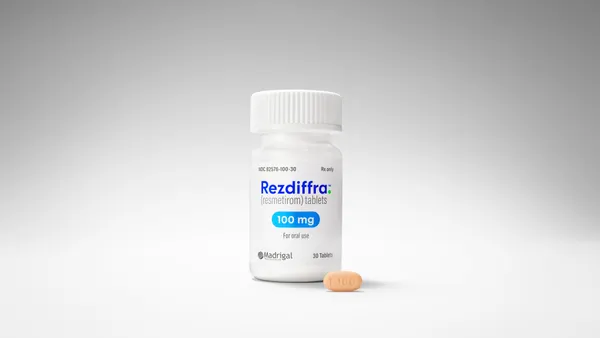Patient registries Observations of the Real World By Denise Myshko There is no such thing as a standard registry. We have to strike a balance: do we ask a lot of questions or just a few? We also need to consider the work load for the investigators. DR. herve Caspard Through patient registries, pharmaceutical companies can obtain real-world effectiveness data about products, including adverse events and outcomes in various patient populations, that go beyond the limited confines of controlled trials. Postapproval research in one form or another has been around for more than 30 years. Recently the Food and Drug Administration has stepped up its demand on drug developers to conduct more certain, effective, and timely postmarketing studies (see related box on page 41). While most of these studies fall under mandatory postmarketing commitments (PMCs), some voluntary studies are starting to gain popularity as ways of conducting outcomes research. In particular, pharmaceutical companies are adding patient registries to their postmarketing toolkits. Traditionally, registries have been used as a way to survey the safety of approved drugs in pregnant women, for example, as well as to observe data from clinical practice. The success of some of the largest disease registries — such as Genentech’s National Registry of Myocardial Infarction (NRMI) — has spurred companies to expand their use. Industry experts believe that pharmaceutical companies will develop registries as tools to generate real-world data for their products. Already, sponsors are starting to incorporate both scientific and commercial objectives into their postmarketing programs, which is expected to lead to more product-specific programs with risk-management plans and fewer disease-specific registries. “One of the reasons that registries are hot now is that sponsors recognize a huge number of value drivers,” says Richard Gliklich, M.D., president and CEO of Outcome. “Registries, if properly constructed, have the ability to generate a lot of data for publications, and publications drive postapproval sales. Companies also can get competitive intelligence, particularly when they do a disease registry.” Genentech’s registry is one of the largest observational studies of acute myocardial infarction (AMI). Since 1990, NRMI has collected data on more than 2 million AMI patients and helped more than 1,600 participating hospitals assess their approach to AMI treatment and identify trends in patient outcomes. Dr. Gliklich says such registries can allow companies to view, in real time, the market dynamics of what’s happening with a drug or device. “Increasingly, companies are viewed as a knowledge partner with physicians because they are actively engaged in increasing the scientific knowledge about a disease process, and physicians and hospitals respond positively,” he says. Cyndi Verst-Brasch, Pharm.D., VP, Kendle Late Phase, says pharmaceutical companies are beginning to seek out contract-research companies and others to act as consultants in the design and implementation of registry programs. “Of course, the primary importance is the scientific nature of the program,” she says. “But now, there is appropriate blending of commercialization objectives into these trials.” On the regulatory front, experts predict that agencies will request more registries as a postmarketing commitment. “As regulatory agencies strive to approve products earlier, they are looking to ensure that biopharmaceutical companies have in place risk-management strategies,” Dr. Verst-Brasch says. “While the FDA may not require a safety-registry study, many companies are being proactive and conducting such a registry as a risk-mitigation approach. Risk management is the new buzzword in this heightened regulatory environment.” According to Christopher-Paul Milne, DVM, MPH, JD, assistant director of Tufts Center for the Study of Drug Development, risk management efforts are just beginning. “There weren’t many risk-management specific PMCs in 2003, but I think we will see more as they are incorporated into the risk-management plan concept,” he says. Clinical-drug development and safety assessments have become much more sophisticated in recent years, with more of an emphasis on defining risk in a more quantitative way, says Sandy Kweder, M.D., deputy director of the Office of New Drugs, at the U.S. Food and Drug Administration. “To define the risk, companies often need to go beyond gathering the data that might be available in a typical new drug application,” she says. In light of FDA requests for more postmarketing data on newly approved drugs, Sean L. Hart, B.S., MBA, CEO of BBCI, says the agency is likely to request restricted access or product-specific registries that identify specific safety signals over time. “FDA officials are discussing risk-management strategies, and that is why we’re hearing more about registries and large simple safety studies,” he says. “The FDA is talking more about registries and large, simple safety studies as part of its new overall risk management/risk assessment pharmacovigilance efforts.” Additionally, registries can help define the safety parameters for drugs with a narrow therapeutic window. “If the population can be defined through an electronic registry — and this really only can be done electronically — then companies will be able to collect data and authorize the dispensing of the drug based on the parameters defined in the registry,” Dr. Gliklich says. “Therefore, more drugs with a narrow safety window could become available for more appropriate populations. The FDA is going to be evaluating this carefully. As a result, this will be a huge opportunity for sponsors because drugs that weren’t necessarily thought safe enough for large populations might be safe for 10% of the population.” Registries vs. Clinical trials Patient registries can be product-oriented, disease-oriented, or focused on a particular patient population. Unlike Phase III or Phase IV trials, registries are not blinded. They may have a comparator group, but there are no inclusion and exclusion criteria for patient recruitment. In other words, all patients taking a particular drug or using a particular device or who have a certain disease are eligible to participate. Registries generally focus on effectiveness while Phase III trials look at efficacy. Registries typically are observational where trials are randomized. And registries tend to be larger than clinical trials. Mr. Hart says to be a true registry, there has to be prospective enrollment of patients receiving a particular drug or a series of drugs within a specific disease. The patients need to be tracked to evaluate a specific effectiveness or safety outcome. “I say effectiveness because we’re really not proving efficacy,” he says. “There has to be a given endpoint, and there has to be a well-constructed data collection method with rigorous follow up. In the past, some registries didn’t have these criteria.” A registry does not try to show that a product is having a particular effect. A registry aims to gather as much data as possible, including information about other drugs a person may be taking or other conditions or illnesses the person may have. In this way, a real-world picture can be drawn about the how the drug affects people in the community. “That real-world, community-based setting often includes younger patients, older patients, sick patients, patients with concomitant medications, concomitant illness, and in some cases, pregnant women,” Mr. Hart says. “Registry and large, simple safety study protocols are much different from those for Phase III trials, which have very restrictive inclusion/exclusion criteria. In registries, practitioners follow the product label and meet the targeted protocol endpoints that have been established.” According to John Walt, MBA, senior manager of global health outcomes strategy and research at Allergan Inc., once a drug is on the market, it is important to understand how it performs in a wider group of patients beyond the patients meeting the inclusion or exclusion criteria of the clinical trial. “A registry doesn’t tell physicians what to measure or when to bring patients back,” he says. “Registries capture what happens to these patients in normal practice. Physicians let us know the results when they do particular measures, and we capture those data.” The primary aim of a registry, Mr. Walt says, is not to submit data to the FDA to make a pivotal claim, change the label, or develop new indications. “Rather, registries are used for either economic reimbursement submission with managed-care organizations and other payers outside the United States or for a better understanding of real patient outcomes in the current market,” he says. “Managed-care organizations, insurers, and payers want to better understand how drugs work compared with other therapies not versus placebo. Managed-care organizations would rather see results from a registry than a Phase IV study in the same patients as the pivotal clinical trials.” According to Dr. Milne, pharmaceutical companies are using patient registries as a way to control information flow and data collection after a drug reaches the market. “This information can be used to detect and follow up on safety signals, as well as for marketing purposes,” he says. “Marketing-based registries are used to identify issues related to product use and to identify factors that might impact prescribing decisions,” says Deborah Covington, Dr.PH., director of registries and epidemiology, at Inveresk Research Group Inc. “Scientific and safety registries focus on supporting and strengthening the safety profile of a particular drug.” To achieve more effective patient recruitment, Colin Lucas-Mudd, CEO of NCERx LLC, says the clinical and marketing aspects need to be integrated. “The aim is to build consumer and patient trust and turn that into permission through registrations,” he says. “The registrations form the core, and from that we get permission to append other data and then we can use those records for patient recruitment through to marketing.” Since registries are hypothesis-generating studies and not hypothesis-testing studies, the real-world clinical, economic, and humanistic outcomes data are a great way to impact quality of care for patients, says Stephen L. Webb, executive VP of Registrat Inc. “Because biopharmaceutical and medical-device companies can help define best-practice guidelines and standards of care through these studies, they can develop various substudies and generate scientific hypotheses in support of clinical data,” he says. Jeffrey Trotter, president of Ovation Research Group, agrees. “A clinical trial is designed with a specific hypothesis in mind that researchers are trying to prove or disprove, and the statistics are driven by that goal,” he says. “Since a registry is much more hypothesis generating than it is hypothesis proving, statistical analyses and other aspects must accommodate a more flexible approach.” A Registry in action For executives at Proxima Therapeutics Inc., a device manufacturer, a patient registry was the logical way to answer some additional questions that the clinical community had about its MammoSite Radiation Therapy System, an internal radiation therapy system comprised of a balloon catheter that administers a prescribed dose of radiation to targeted breast tissue. The product was approved by the FDA based on clinical safety and performance data from 43 patients. “The number of patients in a clinical trial is not always large enough to answer all of the smaller questions that the clinical community has,” says Timothy J. Patrick, president and CEO of Proxima Therapeutics. “In a registry environment, we have the ability to enroll many more patients and use many more sites. The original study had eight participating sites; there are more than 130 sites involved with the registry.” He says the registry also is helping the company to gather practical information, for instance, patient demographics, related to the users of the therapy. “Through the registry we have been able to confirm that this technology is being adopted in accordance with the recommendations of the professional societies,” he says. “We’ve been able to look at patient age, tumor size, and tumor status. We’re gathering short-term and long-term cosmetic data. Ultimately, we’ll take a look at toxicity and other issues. In the long run, this is a seven-year study that will look at local recurrence rates, which are very important.” Through the registry, data from more than 1,300 patients will be available for analysis, says Peter D. Beitsch, M.D., FACS, coprincipal investigator of the American Society of Breast Surgeons’ MammoSite Patient Registry and director of the Dallas Breast Center. “The goal is to further elucidate the short-term complications and look at efficacy data over the long term,” he says. Proxima Therapeutics plans to use this information for physician education. “Thus far, we’ve trained about 2,000 physicians,” Mr. Patrick says. “One of the best uses of the registry is the ability to provide ongoing updated data to physicians who come into training, which is incredibly important. We present demographic and patient data in our physician-education classes, which in many ways for a small company with a new technology is marketing.” Mr. Patrick says the company originally expected enrollment of about 500 patients. “We didn’t fully anticipate the interest that the medical community would have in a registry to better understand how the technology can be used,” he says. “The next time, we will set our sights a little higher and use an electronic system to more effectively manage the enormous amount of data that is generated.” Today, less than 10% of registries use electronic systems for data capture, says Jonathan Morris, M.D., chairman, CEO, and president of ProSanos Corp. “The regulatory environment for prospective randomized clinical trials has helped define the specifications for EDC implementation,” he says. “In the registry or postlaunch environment, there hasn’t been the same regulatory or business push, so many companies are still trying to figure out exactly what they should do and how they should do it.” Dr. Gliklich says pharma companies need to go beyond traditional EDC systems to collect information for registries. “Because registries serve as a reporting system and as an active knowledge base, there has to be the ability to generate patient-management and practice-management tools for sites,” he says. “The idea is for a registry to become a population-management tool that providers can access.” Registry challenges As with any study, conducting a registry poses some challenges. “Patients may or may not see their physician,” says Leanne R. Larson, senior VP of patient registries, at Ovation Research Group. “They may or may not take their medication. They may or may not complete questionnaires. Companies have to overcome similar issues with physicians.” She says companies likely will be working with sites that may or may not have a research infrastructure or may even be research naive. “Companies have to design and manage a registry program in a way that doesn’t burden the sites,” Ms. Larson says. Registries are different from trials, and every aspect needs to be addressed from the perspective of the strategic goals of the sponsoring organization, Mr. Trotter says. “One of the challenges that we often face is working with internal groups that may or may not have a consistent understanding of the registry,” he says. & 8220;Each registry is different and should be tailored to address specific needs,” says Herve Caspard, M.D., Sc.D., director of epidemiology, U.S. health outcomes/medical, at Sanofi-Synthelabo Inc. “For example, we should not hesitate to simplify the case report form when we just want a little information.” Mr. Webb says because the return on investment (ROI) for registries is a little softer, measuring their value can be a challenge as well. “There are objective ways to measure ROI, such as market-share data and the effects a registry can have in terms of penetrating and expanding the marketplace, as well as patterns of product use,” he says. “From a scientific standpoint, registry data can be disseminated through abstracts and manuscripts, scientific presentations, and investigator meetings to help them improve outcomes for their patients.” Dr. Morris points out that there is another value that often doesn’t get added into the equation: the prospective capture of data that can be used for a scientific marketing plan. “The use of registry data by providers themselves to potentially change their own prescribing behavior or increase visibility and awareness, can be a much more effective selling tool than a pure sales detail or other traditional marketing tactics,” he says. “Having a registry that can be used by specific providers or institutions is good medicine and good marketing.”F PharmaVoice welcomes comments about this article. E-mail us at [email protected]. dr. jonathan morris Companies that view registries as an effective growth tool and not just a burden or an obligation will be the most successful. john walt Once a drug is on the market, we want to understand how it performs in a wider group of patients beyond the patients meeting the inclusion/exclusion criteria of the clinical trials. leanne larson With HIPAA requirements, receiving patient consent for registry participation is critical. timothy patrick The number of patients treated in an initial clinical trial is not always large enough to answer all of the questions that the clinical community has following publication of study results. A registry can be a great way to address those additional questions. Experts on this topic Peter D. Beitsch, M.D., FACS. Coprincipal Investigator of the American Society of Breast Surgeons’ MammoSite Patient Registry and Director, Dallas Breast Center, Dallas; The American Society of Breast Surgeons was formed to encourage the study of breast surgery, to promote research and development of advanced surgery techniques, and to improve standards of practice for breast surgery. For more information, visit breastsurgeons.org. Herve Caspard, M.D., Sc.D. Director, Epidemiology, U.S. Health Outcomes/ Medical, Sanofi-Synthelabo Inc., New York; Sanofi-Synthelabo is the U.S. affiliate of the global pharmaceutical company Sanofi-Synthelabo, with a focus on cardiovascular disease and thrombosis, diseases of the central nervous system, oncology, and internal medicine. For more information, visit sanofi-synthelabo.us. Deborah L. Covington, Dr.Ph. Director of Registries and Epidemiology, Inveresk Research Group Inc., Wilmington, N.C.; Inveresk is one of the world’s largest CROs, offering a wide range of product development services to the pharmaceutical, biological, and related industries. For more information, visit inveresk.com. Richard Gliklich, M.D. President and CEO, Outcome, Cambridge, Mass.; Outcome is a provider of electronic patient registries and postmarketing studies and has managed more than 50 online registries enrolling more than 1 million patients. For more information, visit outcome.com. Sean Hart, B.S., MBA. CEO, BBCI, Kansas City, Mo.; BBCI is a contract research organization formed in 1976 that specializes in designing and managing late-stage drug development (Phase III, IIIB, and IV) programs. For more information, visit bbclinical.com. Sandy Kweder, M.D. Deputy Director, Office of New Drugs, U.S. Food and Drug Administration, Rockville, Md.; the FDA is responsible for protecting the public health by assuring the safety, efficacy, and security of human and veterinary drugs, biological products, medical devices, food supply, and cosmetics. For more information, visit fda.gov. Leanne R. Larson. Senior VP, Patient Registries, Ovation Research Group, Highland Park, Ill.; Ovation Research Group is a health economics and outcomes research and consulting firm that serves pharmaceutical, medical-device, and biotechnology companies around the globe. For more information, visit ovation.org. Colin Lucas-Mudd. CEO, NCERx LLC, Carlsbad, Calif.; NCERx is a private interactive healthcare publisher dedicated to delivering timely healthcare information to consumers and matching clinical-trial candidates with investigator sites and sponsors. For more information, visit ncerx.com. Christopher-Paul Milne, DVM, MPH, JD. Assistant Director, Tufts Center for the Study of Drug Development, Boston; The Tufts Center for the Study of Drug Development is an independent, academic, nonprofit research group affiliated with Tufts University. For more information, visit http://csdd.tufts.edu. Jonathan Morris, M.D. Chairman, CEO, and President, ProSanos Corp., La Jolla, Calif.; ProSanos is a privately held biomedical informatics company that provides data integration and analysis products and consulting services to clients in the pharma and biotech, government/research, and provider sectors. For more information, visit prosanos.com. Timothy J. Patrick. President and CEO, Proxima Therapeutics Inc., Alpharetta, Ga.; Proxima Therapeutics is a privately held medical-device company that develops and markets innovative radiation delivery systems for the treatment of solid cancerous tumors, with an initial focus on brain and breast cancer. For more information, visit proximatherapeutics.com. Jeffrey Trotter. President, Ovation Research Group, Highland Park, Ill.; Ovation Research Group is a health economics and outcomes research and consulting firm that serves pharmaceutical, medical device, and biotechnology companies around the globe. For more information, visit ovation.org. Cyndi Verst-Brasch, Pharm.d. VP, Late Phase, Kendle International Inc., Cincinnati; Kendle is among the world’s leading global clinical-research organizations, delivering clinical-development solutions. For more information, visit kendle.com. John Walt, MBA. Senior Manager, Global Health Outcomes Strategy & Research, Allergan Inc., Irvine, Calif.; Allergan is a global specialty pharmaceutical company that develops and commercializes products for the eye care, neuromodulator, skin care, and other specialty markets. For more information, visit allergan.com. Stephen L. Webb. Executive VP, Registrat Inc., Lexington, Ky.; Registrat provides strategic solutions to design and implement registries and peri-approval programs. For more information, visit registrat.com. jeffrey trotter We view registries as an important opportunity for our clients to better understand how diseases are managed in the real world. Registries fill an important niche between formal clinical trials and unstructured views of the marketplace. Postmarketing Commitments Grow Postmarketing commitments (PMCs) are rapidly becoming an essential element of new drug development in the United States. Registries are one type of PMC. The Tufts Center for the Study of Drug Development this year began a five-year research program to evaluate how the FDA’s PDUFA III programs, which include greater emphasis on Phase IV studies and risk management in the postmarketing period, have affected new drug R&D. Tufts CSDD Impact Report is the first in a series that will help provide a benchmark for structuring PDUFA IV, to be voted on by Congress in 2007. According to Tufts CSDD analysis, which was released in July, PMCs mandated by specific regulations began during the mid-1990s with the introduction of the accelerated approval program. Use of PMCs increased with the addition of deferred pediatric studies under the 1998 pediatric rule (now codified as the Pediatric Research Equity Act of 2003), and, more recently, the animal rule in May 2002. Other findings include: n Between 1998 and 2003, mandatory postmarketing studies accounted for about one-third of the 492 performed studies. n The number of patients in studies has grown from a median of 30 in the 1970s to 123 in the 1980s, jumping to 920 in the 1998 to 2003 period. n The number of PMCs per NME increased from 2.7 in the 1970s to 3 in the 1980s to 4.4 in the 1998 to 2003 period. n The median cost of studies rose from $135,000 in the 1970s and 1980s to $3.7 million in the 1998 to 2003 period. n During 1998 to 2003, efficacy-related and drug interaction studies outnumbered all others. The high percentages for efficacy and drug/drug categories are likely the result of the contribution of studies required for accelerated approval, as these two study types are the ones most often requested by FDA to support such approvals. n Safety/ADR postmarketing studies have been employed with increasing frequency — from 5% of all PMCs in the 1970s to 13% in the 1980s, as well as in the 1998 to 2003 period — to monitor a drug once it reaches a wider patient population. n More PMCs have been conducted in connection with NMEs than for non-NMEs (previously approved new molecular entities). Priority review drugs, on average, required 2.4 times as many PMCs as standard review drugs. Accelerated approvals comprised only 18% of the approvals with PMCs but accounted for 29% of all PMCs for NMEs in 1998 to 2003. n On average, new drugs approved in 1998 to 2003 involved 4.4 PMCs, but oncology drugs, with an average of 5.6 PMCs per approval, involved three times as many studies as cardio-renal drugs. Source: Tufts Center for the Study of Drug Development, Boston. For more information, visit http://csdd.tufts.edu. Dr. Cyndi Verst-Brasch The FDA is now requiring more postmarketing commitments, registries, or prospective surveillance studies. In fact, the agency commonly requires postmarketing studies to verify the approved drug’s clinical benefit, including long-term safety profile. Dr. Peter Beitsch This union is really where innovation and knowledge are going to come from in the future. Dr. Deborah Covington The FDA is definitely encouraging pharmaceutical companies to implement Pregnancy registries, especially among drugs that are typically used by women of childbearing potential.
An article from











